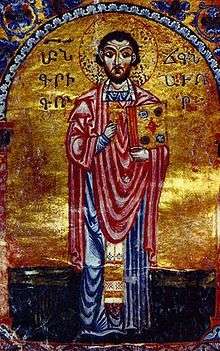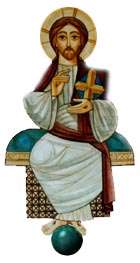Gregory of Narek
| Saint Gregory of Narek | |
|---|---|
 Gregory of Narek as depicted on an 1173 manuscript | |
| Monk, Doctor of the Church | |
| Born |
951 Narek, Vaspurakan, Kingdom of Vaspurakan, Bagratid Armenia (now Yemişlik, Van Province, Turkey) |
| Died |
1003[1] or 1010[2] Narek, Vaspurakan, Kingdom of Vaspurakan, Bagratid Armenia (now Yemişlik, Van Province, Turkey) |
| Venerated in |
Armenian Apostolic Church Armenian Catholic Church Roman Catholic Church |
| Feast |
13 October (Holy Translators day) 27 February (Roman Catholic Church) |
| Part of a series on |
| Oriental Orthodoxy |
|---|
 |
| Oriental Orthodox churches |
|
Subdivisions
|
|
History and theology
|
|
Major figures
|
|
|
Gregory of Narek (Armenian: Գրիգոր Նարեկացի Grigor Narekatsi, Western Armenian: Krikor Naregatsi; 951 – 1003) was an Armenian monk, poet, mystical philosopher, theologian, and composer who is venerated as a Saint by both the Armenian Apostolic and Roman Catholic Churches. Born into a family of scholars and based in Narek Monastery near Lake Van, he is regarded as "Armenia's first great poet".[3]
He is the author of a mystical interpretation on the Song of Songs and numerous works of poetry in Classical Armenian. His Book of Prayers, also known as Book of Lamentations, is a long mystical poem in 95 sections. It was written around 977 and has been translated into many languages. More than a thousand years after its author's death, The Book of Lamentations remains one of the definitive works of both Armenian literature, theology, and spirituality.
In 2015, Saint Gregory of Narek was declared a Doctor of the Church by Pope Francis.[4]
Biography
Gregory was born c. 950 to a family of scholarly churchmen. His father, Khosrov of Andzev, was an archbishop. He lost his mother very early, so he was educated by his cousin, Archimandrite Anania of Narek, who was the founder of the monastery and school of the village. At a young age, Gregory entered Narek Monastery on the south-east shore of Lake Van in Vaspurakan, (Greater Armenia, now Turkey) and spent almost all of his life there. Shortly before the first millennium of Christianity, Narek Monastery was a thriving center of education, devotional theology, and the production of illuminated manuscripts. The Armenian Church was experiencing a renaissance in literature, painting, architecture and theology, of which St. Gregory was a leading figure. Gregory also taught at the monastic school until he died in 1003.
Legacy
Narek Monastery

After Saint Gregory's death in 1003, his relics remained a source of veneration to pilgrims.
Numerous miracles and legends were also attributed him and he began being referred to as "the watchful angel in human form".
In 1858, Narek Monastery was renovated by Hovhannes Vardapet. In the process, Father Hovsep Rabuni commissioned a khachkar or cross stone, which was placed on the tomb of Gregory of Narek. It depicted the Mother of God carrying Jesus Christ on her lap and Saint Gregory on the foreground.[6]
During the 1915 Armenian Genocide, the monks of Narek and almost the entire local Armenian population was murdered. The tomb and relics of Saint Gregory, which had been venerated by pilgrims for centuries, are believed to have been destroyed.
The ruins of the monastery were demolished by the Turkish Government in 1951. The remains of an arch and some ancient gravestones remained visible until the early 2000s, but have since been destroyed as well. The Turkish Government has recently erected a mosque on the site of Narek Monastery, which serves the mainly Kurdish population of the surrounding village.
Book of Prayers / "Book of Lamentations"
Written shortly before the first millennium of Christendom, the prayers of St. Gregory of Narek have long been recognized as gems of Christian mysticism. St. Gregory called his book an "encyclopedia of prayer for all nations". It was his hope that it would serve as a devotional guide to people throughout the world.
A teacher of the well developed school of Christian monasticism at Narek Monastery, at the request of his fellow monks he set out to answer an imponderable question: what can each person offer to God, who already possesses all and knows all better than sinful humans can ever express? To this question, posed by the prophets, psalmists, apostles, and saints, Saint Gregory provides an answer – the sighs of a contrite and humble heart.
In the book's 95 prayers, St. Gregory drew upon the potential of Classical Armenian to transform suffering and humility into an offering of words pleasing to God. Calling it his last testament: "its letters like my body, its message like my soul". The Book of Lamentations is an edifice of faith for the ages and is unique in Christian literature for its rich imagery, its subtle theology, its Biblical erudition, and the sincere immediacy of its communication with God.
The actual date he started the book is not known, but he finished it around 1001–1002, one year prior to his death.
Classical Music
In 1984–1985, Alfred Schnittke, a classical composer of mixed Jewish and Volga German descent, composed a Choral concerto consisting of prayers from Saint Gregory's Book of Lamentations, which had been translated into Russian by Naum Grebnev. A Christian mystic living in the militantly Atheist Soviet Union, Schnittke drew heavily on the traditional choral music of the Russian Orthodox Church while writing the Concerto. The result has been called one of the greatest choral works ever composed during the 20th century.
Psychology
Armen Nersisyan, a professor of psychiatry, developed a unique type of therapy based on Gregory of Narek's Book of Lamentations, called Narekabuzhutyun in (Armenian: Նարեկաբուժություն).[7] Nersisyan claims that the therapy has treated fully or at least partially many diseases, including schizophrenia, Hepatitis C, periodic disease, stress symptoms and depression.[8]
Veneration in the Roman Catholic Church
Gregory of Narek is venerated as a saint by the Roman Catholic Church, and is particularly loved by Catholics of the Armenian Rite. His name is listed among the saints for 27 February in the Roman Martyrology. He is also mentioned by name in Article 2678 of the Catechism of the Catholic Church.[9]
Pope John Paul II
Pope John Paul II referred to Gregory of Narek in several addresses[10][11][12] as well as in his encyclical Redemptoris Mater[13] and in his Apostolic Letter for the 1,700th Anniversary of the Baptism of the Armenian People.[14]
Doctor of the Church
On 21 February 2015, it was announced that Saint Gregory of Narek would be named a Doctor of the Church by Pope Francis.[15][16][17]
The decision was somewhat controversial. According to critics of Pope Francis' decision, Saint Gregory was monk of the Armenian Apostolic Church, which split off from the rest of Christendom over the Council of Chalcedon in 451 AD. Therefore, Saint Gregory is seen by some Catholics as a Monophysite who was in union with neither Catholic or Orthodox Christians at the time of his death in 1003. (See Oriental Orthodoxy and Chalcedonian Christianity).
Defenders of the decision, however, have cited historical evidence that Narek Monastery, where Saint Gregory lived and died, was a center of opposition to Monophysitism from inside the Armenian Church. It is also cited that Saint Gregory of Narek is listed in the Roman Martyrology with a feast day of February 27th and that Catholics of the Armenian Rite have always had a strong devotion to him and his writings.
On 12 April 2015, Divine Mercy Sunday, during an Armenian Rite Mass for the hundredth anniversary of the Armenian Genocide, Pope Francis officially proclaimed Saint Gregory of Narek as Doctor of the Church.[18]
St. Gregory's proclamation as a Doctor of the Church was commemorated by The Vatican with a postage stamp issued September 2, 2015.
A statue of the new Doctor of the Church was unveiled on April 5, 2018 in the Vatican Gardens by Pope Francis in the presence of Armenia's President Serzh Sargsyan and the Patriarchs of the Armenian Apostolic and Armenian Catholic Churches.[19][20]
Translations
- Grigor Narekatsi. Lamentations of Narek. Mystic Soliloquies with God. Edited and translated by Mischa Kudian. Mashtots Press. London 1977.
- Grigor Narekatsi. Kniga Skorbi, translated into Russian by Naum Grebnev, Preface by Levon Mkrtchian, Sovetakan Grokh, Yerevan, 1977
- St. Grigor Narekatsi. Speaking with God from the Depths of the Heart. Translation and introduction by Thomas Samuelian. Yerevan: Vem, 2001.
- Kéchichian, Isaac, s.j. (introd., trad. et notes). Grégoire de Narek: Le Livre de Prières. Paris: Editions du Cerf, 1961.
- Mahé, Annie et Jean-Pierre (introd., trad. et notes). Grégoire de Narek: Tragédie, Matean Olbergut'ean, Le Livre de lamentation. Louvain: Peters, 2000 (Corpus Scriptorum Christianorum Orientalium; vol. 584. Subsidia, t. 106).
- Samwel Poghosyan, "My Narekaci" Yerevan, 2007
- The Letter of St. Gregory of Narek Translated with annotations by Frederick Cornwallis Conybeare, CrossReach Publications, 2015
- Ervine, Robert (trans.). The Blessing of Blessings: Grigor of Narek's Commentary on the Song of Songs. Kalamazoo, MI: Cistercian Publications, 2007
- Terian, Abraham (trans). The Festal Works of St. Gregory of Narek: Annotated Translation of the Odes, Litanies, and Encomia. Collegeville, MN: Liturgical Press, 2016
Recordings
- Alfred Schnittke. Choir Concerto (Concerto for Mixed Chorus). Valery Polyansky directs the Russian State Symphonic Cappella. Duration: 45 minutes (43'44"). CHANDOS CHAN 9332 (CD)
- Alfred Schnittke. Choir Concerto. The Danish National Radio Choir with Stefan Parkman. Chandos Records CHAN 9126. © 1992 Chandos Records (CD)
- Alfred Schnittke. Compositions for Choir a Capella. Concerto for Choir in 4 Parts, verses by Grigor Narekatsi, Book of Lamentations, or Kniga Skorbi, translated into Russian by Naum Grebnev. Chamber Choir of the Moscow Tchaikovsky Conservatory. Art Director and Conductor Boris Tevlin. Sound director Petr Kondrashin. SFT. © Boris Tevlin 2002. (CD)
- Collected Songs Where Every Verse is Filled with Grief, arranged by the Kronos Quartet (David Harrington, 1997) from Alfred Schnittke's "Concerto for Mixed Choir." Recorded: 1993–97 Length – 8 min 13 sec Studio / Live: Studio. Performers: Dutt, Hank — Viola ; Harrington, David — Violin; Jeanrenaud, Joan — Cello; Sherba, John — Violin.
Bibliography
- Nikoghos Tahmizian, Grigor Narekatsi and the Armenian Music from 5th to 15th Centuries (in Armenian), 1985, Armenian Academy of Sciences, Yerevan, Armenia.
- "My Narekatsi" Samvel Poghosyan, Yerevan, 2007, http://grigornarekaci.su/one_books.php?book_id=3
References
- ↑ Nersessian, Vrej (2001). The Bible in the Armenian Tradition. Getty Publications. p. 46. ISBN 9780892366408.
- ↑ Herzig, Edmund; Kurkchiyan, Marina (2004). The Armenians: Past and Present in the Making of National Identity. Routledge. p. 63. ISBN 9781135798376.
- ↑ Shoemaker, M. Wesley (2013). Russia and The Commonwealth of Independent States 2013. Lanham: Rowman & Littlefield. p. 211. ISBN 9781475804911.
- ↑ "Pope Francis declares Armenian saint Doctor of the Church". Vatican Radio. 23 February 2015.
- ↑ Russell, James R. (2009). "The rime of the Book of the Dove". In Allison, Christine; Joisten-Pruschke, Anke; Wendtland, Antje. From Daēnā to Dîn. Otto Harrassowitz Verlag. p. 165.
- ↑ Hasratyan, Murad. "Նարեկավանք [Narekavank]". "Christian Armenia" Encyclopedia. Institute for Armenian Studies of Yerevan State University. Archived from the original on 8 December 2014.
- ↑ "Նարեկաբուժություն` սա բժշկության մեջ նոր տերմին է (ռեպորտաժ)" (in Armenian). Armenia TV. 3 February 2014.
- ↑ Tovmasyan, Satenik (9 March 2015). "Narek Therapy: Armenians read medieval monk's verses as cure for ailments". ArmeniaNow.
- ↑ "Archived copy". Archived from the original on 2010-09-07. Retrieved 2010-10-07.
- ↑ http://w2.vatican.va/content/john-paul-ii/en/audiences/2000/documents/hf_jp-ii_aud_20001018.html
- ↑ http://w2.vatican.va/content/john-paul-ii/en/angelus/2001/documents/hf_jp-ii_ang_20010218.html
- ↑ http://w2.vatican.va/content/john-paul-ii/en/audiences/2002/documents/hf_jp-ii_aud_20021113.html
- ↑ "Archived copy". Archived from the original on 2015-02-04. Retrieved 2016-03-18.
- ↑ http://w2.vatican.va/content/john-paul-ii/en/apost_letters/2001/documents/hf_jp-ii_apl_20010217_battesimo-armenia.html
- ↑ McCarthy, Emer (February 23, 2015). "Pope Francis declares Armenian saint Doctor of the Church". Vatican Radio.
- ↑ "10th-century Armenian mystic, poet and monk St Gregory of Narek to be a Doctor of the Universal Church". The Catholic Herald. 23 February 2015.
- ↑ https://www.youtube.com/watch?v=lUFesF-Q880
- ↑ http://w2.vatican.va/content/francesco/en/messages/pont-messages/2015/documents/papa-francesco_20150412_messaggio-armeni.html
- ↑ https://www.azatutyun.am/a/29148075.html
- ↑ http://press.vatican.va/content/salastampa/en/bollettino/pubblico/2018/04/05/180405d.html
External links
| Armenian Wikisource has original text related to this article: |
